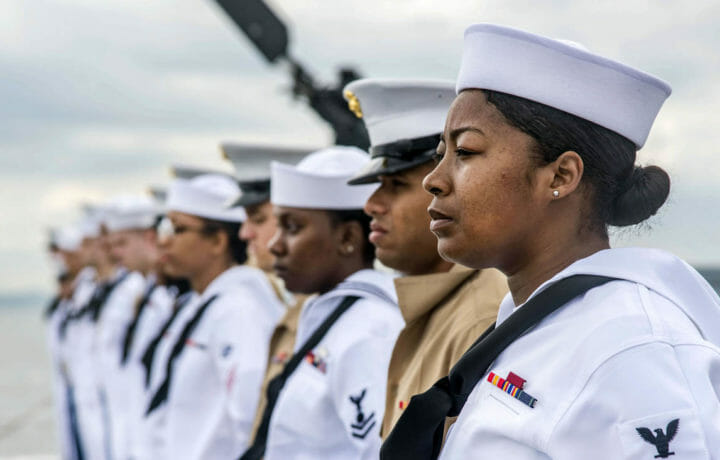On Monday, Geoff Ziezulewicz, a reporter for independent newspaper Navy Times, published the first of four bombshell stories on the full report on the fatal collision of Navy destroyer USS Fitzgerald off the coast of Japan last year. The Navy brass had hoped to keep the report under wraps, but predictably, someone leaked. This story should probably qualify for “Leak of the Week” status, but in this case, the leak is the least troubling part.
The cascade of failures is mind-boggling, and highlights just how defense spending—applied in the proper places—is inexorably linked to readiness. Before the Navy can proceed on its stated path to a 355-ship fleet, it ought to have to show that it can properly man its current vessels with crew who have the proper training. Because one of the report’s glaring conclusions is that junior Surface Warfare Officers (or SWOs, those Navy officers who lead surface ships) are not only overworked, they’re not properly trained in their jobs.
This is where the money comes in.
Formal Schooling vs. On-the-Job Training
The phrase “learn the ropes,” meaning to learn a specialized skill, is a nautical term. In the days of sailing vessels, there were hundreds of ropes hanging about the ship, and sailor had to learn what each of them did. In those days, there was no “sailing school;” seamen learned on the job. In late December of 2002, the Navy made the decision to go back to that model, cutting down to four weeks its initial six-month SWO training program that had been the norm since 1975.
I’m a ground warfare guy. My Navy experience is limited to my work in the Pentagon and my friendships with Navy officers. But as a former Army officer, there’s one thing I believe the Army and Marine Corps do correctly. Officers are expected to be tactically and technically competent before they’re sent to be in charge of other soldiers or Marines. Those officers are not expected to know everything, but both services insist that their newly commissioned second lieutenants attend months-long schools that teach them job-specific skills.
For me, it was the Armor Officer Basic Course at Fort Knox, Ky. We learned our way around both tanks and infantry vehicles, how to maintain them (and how to do the paperwork associated with maintenance), what the parts were called, and how everything worked. We learned to shoot them and drive them, even though those wouldn’t be our jobs. And we learned the tactics associated with fighting them. If you’re going to show up to your first assignment at the age of 22, less than a year out of college and be in charge of people who have been doing their jobs for many years, you had better have a pretty solid understanding of everyone’s job.
There’s still plenty of on-the-job training. In fact, particularly in a training environment, a platoon leader’s most important job is to make mistakes and learn from them, so he or she can avoid the same mistakes as a company commander. But the Navy decided to ditch its formal education and throw its ensigns directly into their jobs. The results have been disastrous. After the Fitzgerald and McCain collisions last year, a retired Navy captain told Navy Times, “We do not put a premium on being good mariners.”
Pardon me for thinking the Navy ought to teach its SWOs how to drive boats. I’m not alone, either. Problems with the SWO training program were evident by 2007, when one Navy captain wrote that junior offers lacked seamanship and an understanding of their roles.
The service did tighten some of its SWO requirements about six months ago, but those charges seem to be on the margins. Because fixing the SWO problem will cost money, money that is currently going into building a larger fleet.
Unsolicited advice from a ground pounder
Readiness requires training, and the people and tools to conduct it. Those things are costly, but not as costly as lives lost needlessly.
First, the Navy needs more officers. Fatigue was a major contributing factor in both mishaps. It is common across the military to brag about not needing sleep. But fatigue, as demonstrated here, leads to mistakes that needlessly cost lives. More officers to stand watch means more rest time. But officers, even junior ones, are expensive.
Second, the Navy should reinstitute the on-shore schooling, and add even more simulation training than it has in the past. The Army has realized the power of simulations; in fact the “Synthetic Training Environment” is one of the eight cross-functional teams under the new Army Future Command. There is no reason the Navy cannot build exact replicas of the controls that ensigns will face on the water, and pair them with sophisticated software to simulate the most challenging of tasks. No reason, that is, except money.
But in Fiscal Year 2019, Congress gave the Navy more than $24 billion for shipbuilding and conversion, almost $2.2 billion more than the administration asked for. Congress ought to insist that the Navy outfit those new and upgraded ships with crews who are adequately trained in the requirements of how not to crash the boat. and congress ought to cough up the money to do it, even if it means we slow down the procurement of more sexy hardware.
Ships and planes are shiny and sexy, and building them creates lots of jobs. That’s important. But it’s not as important as ensuring that sailors don’t die because of the gross negligence and incompetence of the officers entrusted with operating them.
(I am indebted to Navy Capt. James “Tate” Robinson, whom I have never met, but whose 2008 Army Command and General Staff College thesis is an outstanding look at the history of Surface Warfare Officer training the the Navy; the conclusion here, and any mistakes, are purely mine).




